SALEM, Ore. (Legal Newsline) - A woman who admitted she rear-ended another car while glancing at her cellphone can’t avoid liability for the other driver’s emotional trauma and subsequent suicide attempt, the Oregon Supreme Court ruled, overturning an appeals court’s decision that the suicide attempt wasn’t foreseeable.
In a highly technical decision that drew the interest of the Oregon Trial Lawyers Association, the state’s high court ruled that Leslie Kesselring exposed herself to a damages verdict as soon as she acknowledged responsibility for the accident. Under Oregon law, defendants are generally liable for any injuries stemming from an accident, or as the old legal saying goes, “the defendant takes the plaintiff as she finds her.”
Kesselring argued the jury was unfairly swayed by evidence she was looking at her cellphone at the time of the accident and that it was irrelevant to the question of whether the plaintiff’s suicide attempt months later was a foreseeable injury.
Michelle Scott sued Kesselring after her car was hit from behind, seeking nearly $500,000 in damages including $350,000 for pain and emotional trauma. Kesselring admitted before trial she was following too close in rainy conditions and had glanced down at her phone to make a non-emergency call before the collision.
Kesselring argued that her use of a cellphone did not affect whether it was “foreseeable” that the plaintiff would attempt suicide, making the cellphone use irrelevant. The trial judge disagreed, and the jury awarded Scott $241,000 in damages. An appeals court reversed the verdict, finding the cellphone evidence was irrelevant.
The Oregon Supreme Court ruled that was an error, however, and restored the damages verdict in a July 8 decision. Foreseeability is an essential element of any tort case, the court ruled, but once Kesselring admitted her negligence was to blame for the accident, she couldn’t contest evidence about her conduct leading up to the accident.
“When a defendant admits responsibility for initial harm, but contests liability for subsequent conduct and harm, the foreseeability inquiry is still an inquiry about defendant’s conduct and whether it unreasonably created a foreseeable risk,” the court ruled. “And a decision to use a cellphone could be considered less reasonable and the risk more foreseeable than would a driver’s glancing away for a reason that did not require the same mental attention.”
The defendant might have succeeded in keeping out evidence of cellphone use if her lawyers made different arguments, such as that the plaintiff’s suicide attempt was due to poor relations with her husband, the court ruled. But since she only challenged on foreseeability grounds, the trial judge was correct to allow the evidence in.
In a footnote, the Supreme Court said it didn’t decide whether a plaintiff’s suicide or attempted suicide raised the question of the extent of the injuries, precluding consideration of foreseeability, or “subsequent conduct” where the jury could consider foreseeability. In other states, the court observed, juries have been able to consider the foreseeability of a suicide even in extenuated circumstances such as when a medical center incorrectly diagnosed a person with HIV.
